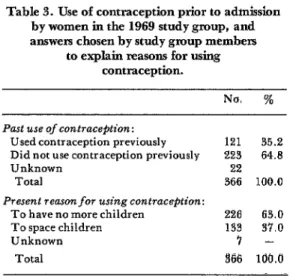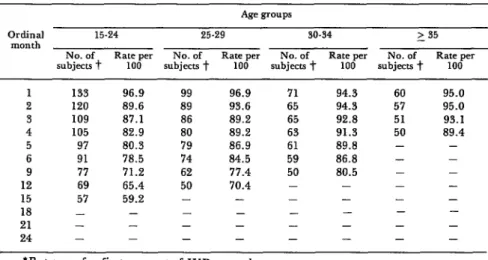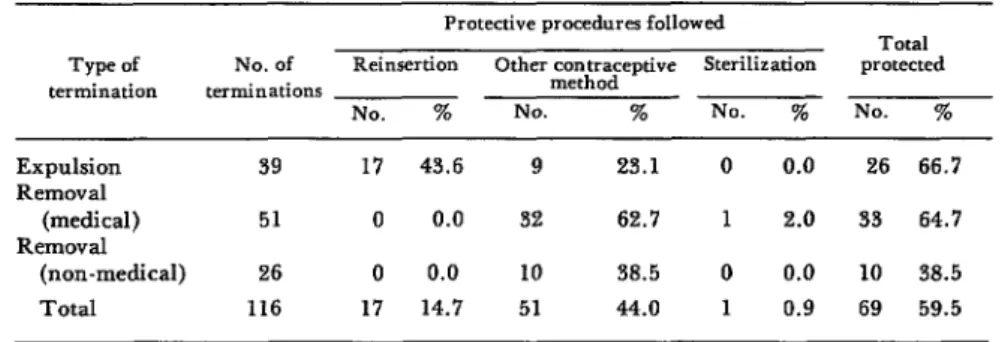Penny Prior,2 Paul N. Seward,,3 Federico Staackman,4 Luis F, Galich, 5
Cynthia Burski,6 and Leo Morris7
Contraceptive continuation rates--the rates at which people continue to use a particular contraceptive method-can be a great help in determining whether a family planning program is effective or whether new contraceptive methods should be introduced. The present article reports on the continuation rates among a group of women who received intra-uterine devices at a large family planning clinic in Guatemala City. In general, their experiences appear to compare favorably with those of IUD users in other areas.
Introduction
A central question in any program of contraceptive services is “What methods of contraception should be provided?” Al- though cost, availability, and acceptability are major determinants of the answer, suc- cessful long-term use of a contraceptive method is recognized as the prime indicator
‘Also appearing in Bol Of Sanit Panam 83(3), 1977. ZFormerly Mathematical Statistician, Family Plan- ning Evaluation Division, Bureau of Epidemiology, Center for Disease Control, Public Health Service, U.S. Department of Health, Education and Welfare, Atlanta, Georgia. Current address: Department of Biostatistics. University of California, Berkeley, California 94122, U.S.A.
SFormerly Medical Officer, FPED, BOE, CDC. Current address: Family Practice Program, San Francisco General Hospital, San Francisco, California 94110, U.S.A.
4Director and Chief Physician, Central Clinic, Guatemalan Association for Family Welfare (APRO- FAM), Guatemala City, Guatemala.
5Director of Medical Services, APROFAM. ‘Formerly Population Officer and Public Health Adviser, U.S. Agency for International Development, Guatemala City, Guatemala.
Titatistician and Assistant Chief, Program Evalua- tion Branch, Family Planning Evaluation Division, Bureau of Epidemiology, U.S. Center for Disease Con- trol, Atlanta, Georgia.
of its value. This means that knowledge of use effectiveness is needed for making the initial decision about whether or not to provide a particular method, as well as for making subsequent decisioss when the pro- gram is well underway.
In their review and evaluation of nation- al family planning programs, Lapham and Maudlin considered continuation rates important for measuring the scope of program operations and the degree of program success (I). For many programs, however, good continuation rate data were not available, And in the specific case of the Latin American counbriee, very little sys- tematic work had been done to study contra- ceptive continuation rates (2).
In 1971, a study of intrauterine contra- ceptive device (IUD) use effectiveness was initiated in urban Guatemala in order to document continua&m rates for this con- traceptive method in a Latin American country. The study examined the first segment of JUD experience among women admitted to a large urban family planning clinic who had their first IUD insertion there between 1July 1969 and 3OJune 1970. Relevant data were recorded and analyzed
using multiple decrement life table tech- niques. Demographic data, data on IUD re- insertions, and data on use of other contra- ceptives following IUD termination were also collected and are presented here.
This study was conducted by the Guate- malan Association for Family Welfare (APROFAM) and the Guatemalan Ministry of Health, with the cooperation of the United States Agency for International Development and the U.S. Center for Disease Control. APROFAM’s Central Clinic was chosen as the site for the study because of the large number of IUD users served and the length of time IUDs had been provided there.
Background
APROFAM is a privately sponsored affiliate of the International Planned Parenthood Federation, which both sepa- rately and in cooperation with the Ministry of Health has sponsored family planning clinics in Guatemala since late 1964 (3). The Central Clinic is both the oldest and largest of these clinics and is located in downtown Guatemala City. The clinic is situated in a large building containing an airy sunlit waiting room, a room for orien- tation and education with lecture and film facilities, a number of examining rooms, a large record room, offices for the director and the social service staff, a small snack bar, and living quarters for the resident caretaker.
As well as operating daily family plan- ning clinics for contraception, the clinic also sponsors a mothers’ club which provides education in nutrition and child care. When the clinic first opened, the major contraceptive method offered was the IUD, and nearly all the patients served during the first year of operation received this device. Even then, however, a few women received oral contraceptives, and since then other methods-including both traditional con-
traceptives and a long-acting injectable agent-have become available.
In addition to contraceptive care, the clinic provides treatment for minor gyne- cological problems, cervical cancer screen- ing, and venereal disease screening and treatment. Laboratoryservicesincludepreg- nancy testing and hematocrit determina- tion. Referrals are made for women with major gynecological problems and abnor- mal cervical cancer cytology, and for those who request prenatal care or voluntary sterilization.
Field services emphasize continuation of contraceptive care and the follow-up of women with abnormal cervical cytology. Field work is carried out principally by social workers, who are capable of provid- ing counseling and who have experience at keeping careful and detailed records of follow-up visits.
Materials and Methods
The cohort of subjects selected for this study was composed of women admitted to the Central Clinic for the first time between 1 July 1969 and 30 June 1970 and who received IUDs during that period. Here- after, this group of IUD users will be referred to as the 1969 study group.
Records of approximately 3,000 women admitted during the study period were examined. These records showed that 367 women first accepted IUDs during that period. One woman was later found to be incorrectly classified and was therefore excluded from the study. The study group thus consisted of 366 women.
last visited the clinic before 1 March 1971 were followed up-by attempting to inter- view them at their last known addresses. These follow-up efforts were completed by March 1972.
Data analysis of IUD use effectiveness involved the use of a multiple decrement life table technique (4,5). For purposes of the life table analysis, relevant terminations included pregnancies, expulsions, removals for medical reasons, and removals for non- medical reasons. Three women who either were pregnant at insertion or had an un- known length of IUD use were excluded from analysis. As explained above, women lost to follow-up or released from follow-up, as well as continuing users, were included in the analysis from the date of first inser- tion to the date of the last determination of the IUD’s presence; thereafter they were handled as competing risks according to the method adapted by Potter (4). Life table analysis was restricted to first segments of IUD use in order to permit computation of life tables in terms of several demographic variables. Only net life table rates are reported. Rates of reinsertion per 100 first segment terminations were caIculated, as were rates of method change.
Results
Cohort Characten’stics
Over 50 per cent of the study group members were between 20 and 29 years of age, and almost 75 per cent were between 20 and 34. Over 90 per cent had had two or more pregnancies (see Tables 1 and 2). Ap- proximately one-third of the women had used contraception before. All of them were asked to state the reason for using contra- ception, and could select either “to have no more children” or “to space the children” as answers. These statements indicated that 63 per cent of the respondents began using contraception at the Central Clinic to have no more children, while the remaining 37
Table 1. Age distribution and average number of past pregnancies among women in the 1969
Central Clinic study group in Guatemala City.
Women in each age group Average No.
As group of past
No. % pregnancies
15-19 years 28 7.7 2.0
20-24 ” 105 28.7 2.9
25-29 ” 100 27.3 4.0
30-34 ” 72 19.7 5.4
35-39 ” 47 12.8 7.0
40-44 ” 12 3.3 8.3
145 ” 2 0.5 6.5
Total 366 100.0 4.3
TabIe 2. Women in study group, classified by number of pregnancies at admission to
the Central Clinic.
Number of past pregnancies
o-1 2-3 4-5 6-7 8-9 I10 Unknown
Total
Women in each category
No. %
36 9.9
129 35.4
107 29.4
43 11.8
36 9.9
13 3.6
2 -
366 100.0
per cent wanted to space their children (see Table 3).
Of the 366 women, 87.4 per cent received size D Lippes loops at first insertion, and 6.8 per cent received size C Lippes loops. The remaining women (5.8 per cent) received Lippes loops of unknown sizes or a device of unknown type and size. Both size C and size D Lippes loops are 30 mm in diameter, but loop D is more rigid than loop C.
L$e Table Analysis
Table 3. Use of contraception prior to admission by women in the 1969 study group, and amwers chosen by study group members
to explain reasons for using contraception.
No. %
Past use of contraception :
Used contraception previously 121 35.2
Did not use contraception previously 223 64.8
Unknown 22
Total 366 100.0
Present reason for using contracefition:
To have no more children 226 63.0
To space children 1‘39 37.0
Unknown 7 -
Total 166 106.0
from pregnancy, expulsion, rem0Val for medical reasons, and removal for nun- medical reasons, as well as the total cumula- tive termination rates. The last column of the table gives the number of women exposed to the risk of IriD discontinuation at the start of the ordinal month for which the rates are reported. This article will only report continuation and total termination rates for months with 50 or more women exposed.
The cumulative continuation rate at the end of the first 12 ordinal months was 72.1
per 100 first insertions. Two years after insertion, an estimated 56 per cent of the subjects were still continuing IUD use. The median length of IUD use was 27 ordinal months.
The termination rates for specific types of discontinuation are shown in columns 2-6 of Table 4. Only 2.2 per cent of the women became pregnant during their first 12 months of IUD use, while 3.2 per cent became pregnant within two years of insertion, Approximately 10 per cent of the women expelled the IUD during the first year of use, and about 13 per cent had ex- pulsions during the first two years of use. Eleven per cent of the women had the IUD removed for medical reasons in the first year, and 19 per cent had medical removals within two years. Overall, medical removals produced a higher net cumulative termina- tion rate than any other single type of dis- continuation. Expulsions were responsible for the next highest net cumulative rate of termination. Four and a half per cent of the women had removals for nonmedical rea- sons during their first year, and almost 9 per cent had non-medical removals during the first two years of IUD use.
Table 5 shows cumulative continuation rates among age groups 15-24, 25-29, 30-34,
Table 4. rriet cumulative life table rates per 109 first insertions for the first segment of IUD use (1969 study group, Central Clinic, Guatemala City).
No. exposed Ordinal Pregnancies Expulsions Removals Remov+ All Total No. Total No. each month to
month per 100 per 100 (ngdfal) (ncm-$;~~l) ';~,a; discontinued per 100 continued per 100 discontinuation risk of
1
2 i 5 6 9 12 15 18 21 24
0.0 0.8 2,8
0.6 2.9 3.1
1.2 4.4 3.4
1.2 6.9
1.2 6.5 54::
1.5 6.9 6.6
1.8 9.8 8.5
2.2 10.2 11.0
2.2 11.4 13.0
3.2 12.4 15.ti
3.2 12.4 17.4
3‘2 13.3 19.0
0.3 3.1
0.9 4.0 1.2 4.6 ::B" 1":: 2.4 9.0 3.4 11.9 4.5 15.5 5.7 18.7 6.2 21.7 6.8 24.2 8.5 27.6
4.0 96.0 363
7.5 92.5 331
Table 5. Cumulative continuation rates per 100 first insertions,* by age group and ordinal month of use, among members of the 1969 study group.
OdiIlal 15-24 25-29 30-34 > 35
month -
No. of Rate per No. of Rate per No. of No. of subjects t subjects f subjects f
Rate per
subjects f
Rate per
100 100 100 100
1 2 3
4 5 6 9 12 15 18 21 24
133
120 109 105 97
91
77 69 57 - - -
96.9 99 96.9 71 94.3 60 95.0
89.6 89 93.6 65 94.3 57 95.0 87.1 86 89.2 65 92.8 51 93.1 82.9 80 89.2 63 91.3 50 89.4 80.3 79 86.9 61 89.8 - - 78.5 74 84.5 59 86.8 - - 71.2 62 77.4 50 80.5 - -
65.4 50 70.4 - - - -
59.2 - - - -
- -
- - - - -
- - - -
*Rates are for first segment of IUD use only.
tThe number column indicates the number of women exposed to the risk of IUD dis- continuation in each ordinal month.
- Less than 50 women exposed at the start of the month.
and over 34 for selected ordinal months. None of the differences between adjacent age groups are substantial. Nevertheless, except for the first ordinal month, the cumulative continuation rates for women 15 to 24 yearsof age are consistently, though not substantially, lower than the corres- ponding rates for any other age group.
As Table 6 indicates, the cumulative con- tinuation rates at the end of six months were almost identical for women with three or four pregnancies (87.2) and those with five or more pregnancies (87.0). In contrast, women with fewer than three pregnancies at admission had a six-month cumulative continuation rate of 70.3 per 100 first inser- tions.
No twelve-month cumulative continua- tion rate is shown for women with fewer than three pregnancies, because there were too few women (41) in the sample to make a valid comparison; but women with three or four pregnancies had a continuation rate of 77.6 per 100 insertions at the end of 12 months, while those with five or more preg- nancies had a continuation rate of 79.8. After the first nine months, women with
five or more pregnancies had generally higher cumulative continuation rates than women with three or four pregnancies. The median length of IUD use was 16 ordinal months for women with up to two pregnan- cies, 27 ordinal months for women with three or four pregnancies, and over 33 ordinal months for women with five or more pregnancies.
There was essentially no difference at six months between the cumulative continua- tion rate for women who had previously used contraception (82.9 per 100 first inser- tions) and the rate for those with no pre- vious contraceptive use (81.7 per 100 first insertions).
Table 6. Cumulative continuation rates per 100 first insertions,* by selected characteristics of 1969 study group.
No. of pregnancies preceding insertion
Ordinal O-2 3-4 5+
month
No. of No. of No. of
subjects t Rate per 100 subjects Rate per 100 subjects Rate per 100
3 72 80.0 117 94.3 121 92.5
6 59 70.3 99 87.2 109 87.0
9 - - 86 81.6 90 81.8
12 - - 80 77.6 78 79.8
15 - - - - 71 78.6
18 - - - -
Ordinal month
No. of livingsons
O-l 2+
No. of subjects Rate per 100 No. of subjects Rate per 100
3 139 85.5 168 94.4
6 119 77.5 146 87.8
9 103 71.3 120 81.3
12 90 64.7 107 79.1
15 80 60.1 90 75.2
18 55 57.1 62 68.1
21 - - - -
24 - - - -
Reason given for using contraception Ordinal
month To have no more children To space children No. of subjects Rate per 100 No. of subjects Rate per 100
3 194 92.2 111 85.3
6 171 85.6 91 76.7
9 140 79.1 81 71.4
12 125 75.5 69 65.7
15 111 72.3 56 60.3
18 72 64.7 - -
21 55 62.6 - -
24 - - - -
*Rates are for first segment of IUD use only.
tThe numbers colutin indicates the number of women exposed to the risk of IUD discontinuation in each ordinal month.
- Less than 50 women exposed at the start of the month.
Table 7. Protection obtained against pregnancy by members of the 1969 study group following first segment expulsions and removals.
Protective procedures followed Type of
termination
No. of Reinsertion terminations
Other~e;~o-ptive Sterilization No. % NO. % No. %
Expulsion Removal
(medical) Removal
(non-medical) Total
39 17 43.6 9 23.1 0 0.0 26 66.7
51 0 0.0 32 62.7 1 2.0 33 64.7
26 0 0.0 10 38.5 0 0.0 10 38.5
116 17 14.7 51 44.0 1 0.9 69 59.5
TOtal protected No. %
involving injection, foam, condom, dia- phragm, or oral methods. Less than 1 per cent of the women who terminated IUD use were surgically sterilized. Of the women who expelled the IUD, 44 per cent obtained another one and 23 per cent adopted some other contraceptive method. Of those whose IUDs were removed for medical reasons, 63 per cent adopted another method and 2 per cent underwent sterilization. And of those whose IUDs were removed for non-medical reasons, 39 per cent adopted another contra- ceptive method. Overall, nearly 60 per cent of all the women with expulsions and re- movals were protected against pregnancy following their first segment IUD termi- nation.
Concluding Comments
These results show that IUD use effective- ness in the Central Clinic compares favor- ably with IUD experience elsewhere. Table 8 shows cumulative continuation rates (for first segments only) reported by the present study, by the Cooperative Statistical Pro- gram (CSP) studies in the United States (6), and by studies of women in Taichung, Taiwan (7) and Alajuela, Costa Rica (8). Since nearly all the IUDs inserted in Guatemala City’s Central Clinic were size C and D Lippes loops, the comparisons in this table are restricted to studies in which such devices were used.
The Taichung rates are lower than rates
Table 8. Results of several studies, show& cumulative continuation rates per 100 first insertions for first IUD segments, by study
and ordinal month of use.
Taichung Ahjuela Central Clinic
Ordinal (Lippes. sizes CSP CSP Costa Rica Guatemala City
month B,C,andD)* (Liw= D) (Lippes C) (Lippa C and D) (Lippes C and D)
12 65.0 71.5 - 72.3 72.1
24 47.7 58.2 55.3 57.5 56.0
36 - 48.8 - 46.2 **
48 - 42.2 - 37.0 **
60 - 37.9 - **
- = Rate not stated.
* = Size B has a slightly smaller diameter than the other two. Sizes C and D have the same diameter, but C is slightly less rigid than D.
found in the other studies. Demographic data are not available for the Taichung women, but in general the women in the Tqichung study were older than Guate- malan women. The Taichung study also contained a larger percentage of rural women.
Tietze’s CSP rates (6) are based on combined data from many studies: both the one-year and the two-year cumulative con- tinuation rates for size D Lippes loops, as well as the two-year rate for size C Lippes loops, are similar to the corresponding rates observed in Guatemala. The rates for
Alajuela, Costa Rica, a neighboring Central American country, are also very similar.
Experience with the IUD at the Central Clinic in Guatemala City indicates that the IUD is an effective method of contraception in urban Guatemala. IUD use at the Central Clinic compares favorably with IUD experience elsewhere. Cumulative continuation rates are similar to both the rates found by the U.S. CSP studies of Lippes loops (sizes C and D), and the rates found by a more recent and geographically closer study in Costa Rica.
SUMMARY Contraceptive continuation rates-the rates at which people continue to use a particular con- traceptive method-can be a great help in deter- mining whether a family planning program is effective or whether new contraceptive methods shquld be introduced. Until now, very little systematic work has been done to study contra- ceptive continuation rates in Latin America.
The present article reports the results of one of the few existing studies on this subject, which examined the IUD experiences of women admitted to a large family planning clinic in Guatemala City. The study showed that these experiences compared favorably with the IUD experience of groups previously studied in Costa Rica, Taiwan, and the United States.
REFERENCES (I) Lapham, RJ., and W.P. Mauldin. Na- tional family planning programs: Review and evaluation. Stud Fum Plann 3(3):29-52, 1972.
(2) Marckwardt, A.M. Findings from Family
Planning Research (Latin American Supple-
ment). Reports on Population/Family Planning, No. 12. Population Council, New York, 1974. (3) Ministerio de Salud Pdblica de Guate- mala. Anuario EstadZstico del Programa Nacio- nal de Planificacio’n Familiar, 1972. Guatemala City, Guatemala, 1974.
(4) Potter, R.G. Use-effectiveness of intra- uterine contraception as a problem in competing risks. In: R. Freedman and J. Y. Takeshita, Family Planning in Taiwan. Princeton Univer- sity Press, Princeton, New Jersey, 1969. pp. 458. 484.
(5) Tietze, C. Intrauterine contraception:
Recommended procedures for data analysis.
Studies in Family Planning, No. 18 (Supple- ment), April 1967.
(6) Tietze, C., and S. Lewit. Evaluation of intrauterine devices: Ninth progress report of the cooperative statistical program. Studies in Family Planning, No. 55, pp. l-40, July 1970.
(7) Chow, L. P. Role of the IUD in a national family planning program. International Jour- nal of Gynecology and Obstetrics 8(5):698-728, 1970.




